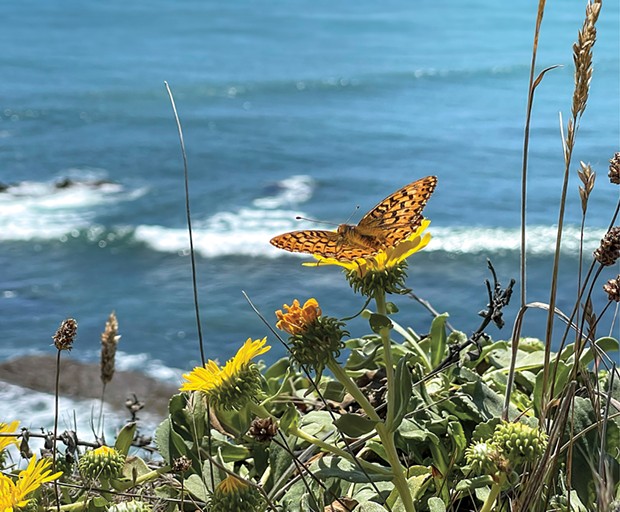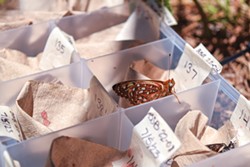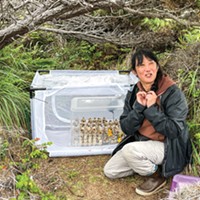Building a Safety Net
Sequoia Park Zoo helps an endangered butterfly species spread its wings
By Kimberly Wear [email protected] @kimberly_wear[
{
"name": "Top Stories Video Pair",
"insertPoint": "7",
"component": "17087298",
"parentWrapperClass": "fdn-ads-inline-content-block",
"requiredCountToDisplay": "1"
}
]
Inside a nondescript concrete building at the Sequoia Park Zoo, hundreds of rare caterpillars are settled down for a long winter's nap.
So small their black, spikey forms only come into focus under the lens of a microscope, the Behren's silverspot butterflies-to-be are housed in specially outfitted jars kept on shelves of a regular kitchen refrigerator, snugly tucked amid grooves of corrugated cardboard.
Painstakingly raised from eggs laid at the zoo by females captured in the wild, the larvae are kept at a cool temperature to simulate weather conditions they would experience in the outside world this time of year. They are in a state known as diapause, a period when they don't need to eat or drink.
"They're not actually asleep but still dormant and not growing," says Christine Damiani, director of the zoo's butterfly conservation program, a partnership with the U.S. Fish and Wildlife Service that is the first and only captive breeding effort for the North Coast species fluttering on the edge of extinction.
As winter turns to spring, Damiani and her team of three part-time assistants will continue to mimic their natural life cycle by warming up the future pollinators, catapulting them from a slumbering state into a living embodiment of The Very Hungry Caterpillar. But unlike the main character in the beloved children's book, these caterpillars only feed on one plant — the dog violet, also known by other names, including the early blue violet — which Damiani raises onsite.
Over the course of a few months, they will grow rapidly under her watchful eyes, passing through six development stages known as instars and eating their way through tens of thousands of leaves, each one handpicked and triple washed by what Damiani describes as "a small army of volunteers."
"We do the best we can to give them the best conditions for survival but we are still learning," she says.
In the summer, those that make it through the transformation from caterpillar to pupa will be taken to the same coastal terrace prairie where their mothers once flitted about. There they will complete the final phase of their metamorphosis into butterflies. This year's brood will be the third group of zoo-raised Behren's silverspots set free near Point Arena, the only place where the butterflies that once ranged from the Russian River in Sonoma County up to around Fort Bragg in Mendocino County are still found, carrying on their wings a new hope for preserving the species into the future.
Getting to this point has been a complex journey, one that began six years ago when the zoo partnered with USFW to raise rare butterflies for release. But the original focus was the Oregon silverspot, an also endangered cousin of the Behren's, which has been successfully raised in captivity at the Oregon Zoo.
Using innovative methods developed at the Portland institution as a template, the plan was to set up another breeding facility closer to the state's only known Oregon silverspot population near Lake Earl in Del Norte County to help boost its plummeting numbers, according to USFW biologist Clint Pogue.
But getting permitted to raise an endangered species is no easy task, requiring Damiani to spend an entire year showing she could successfully rear a closely related but not rare butterfly. By the time the Sequoia Park Zoo program was ready to go, Damiani says, "it was too late" for the Del Norte County colony.
The last female Oregon silverspot found in the area was captured in the summer of 2018, Pogue says, but none of the 150 eggs she laid were fertilized, likely due to low population numbers that left her unable to find a mate.
"Everyone," Damiani says, "was very sad."
None have been spotted in the state since 2019.
"Unfortunately, the Oregon silverspot population in Del Norte County has been undetectable for the last few years," says Pogue, who oversees the agency's California recovery efforts for both subspecies.
So the Sequoia Park Zoo's program pivoted to concentrating on the Behren's silverspot, which is in even more dire straits. Despite the loss in Del Norte, Oregon silverspots are still found in a handful of areas in the insect's namesake state, where its numbers are bolstered by Oregon Zoo's breeding program.
In comparison, Pogue notes, the Behren's silverspot has "no safety net."
Even after being listed as federally endangered in 1997, the butterflies' numbers continued to decline, with an updated USFW recovery plan in 2015 pointing to "the degradation and loss of habitat as a result of development and agricultural practices" as a primary cause, along with trees and invasive species encroaching on the last vestiges of open coastal prairies in the region, shading out the low-growing violets on which the Behren's larvae depend.
The USFW also noted concerns about identifying specific habitat sites due to "impacts from the collection of rare and endangered butterflies" by poachers hunting for the amber-hued butterflies with zig-zagging black lines and dots on the upper wings and distinctive silver spots — hence the name — underneath.
So in 2020, having just watched the Del Norte colony collapse, Pogue says he became "extremely nervous" when only one Behren's was identified in an "incidental" sighting on the insect's last known foothold while official surveys came back empty.
"I had just started doing my work for the recovery of that species and it was doing extremely poorly," he says. "It was definitely nerve-racking to try to ensure the persistence of this species on the landscape."
With those bleak numbers in hand, Pogue says efforts to get the Behren's breeding program up and running "jumped into overdrive." The clock was ticking on putting in place all the logistics needed to proceed the following year — if he was able to collect some female butterflies to bring to the Sequoia Park Zoo.
Luck was on their side.
The next summer, seven females captured in delicate, tightly woven insect nets were carefully secured in ventilated plastic containers with paper towels to latch onto and placed inside coolers to keep them calm during the drive north.
Once there, they laid hundreds of eggs that were meticulously transferred onto petri dishes to continue their life cycle under controlled conditions, which resulted in 80 captive-reared butterflies released in 2022. That same year, another eight females were brought to the zoo, with even bigger results.
This past summer, 245 butterflies emerged from the pupae that Damiani raised and handed off to another team to be placed in protective enclosures at the Point Arena coastal prairie, where they were closely monitored during the final stage of their transformation.
When butterflies first come out of their protective casing, Pogue explains, their abdomens are filled with fluid, which they pump into their wings to inflate them before hanging upside down while their wings dry. That, Pogue says, is "a really important stage for them to complete in the cage before release."
Once the butterflies' wings are dry, the monitoring team "helps them over to a nectar flower so they can get a good meal in before they fly off," he says.
In addition, nearly 300 late instar caterpillars were also set out amid the vegetation to finish their transformation into a pupa after being sent out the door when the banner crop of larvae ate their way through 75,000 violet leaves, depleting the zoo's supply and its ability to keep feeding them.
"The hungry, hungry caterpillar is a true story," Pogue says with a laugh, adding the situation was a positive outcome in his view.
"I think that it's good to put them out at earlier life stages so organisms we're putting out there are experiencing some of the conditions that they would in the wild if it wasn't for this captive breeding and augmentation program, and they're going to be stronger butterflies because of it," he says.
Also contributing to the Behren's recovery is the care the captured females receive during their short stay at the zoo, where they are fed a nectar solution "fortified with a bunch of nutrients and vitamins that has been shown to increase egg production," Pogue says, upping the chances they will lay even more eggs after being released back to the wild to complete their three-week lifespan.
"Those are going to hopefully result in a few butterflies existing on the landscape that went through all of those natural selection pressures and are strong butterflies," Pogue says. "Our main concern is first preventing extinction, but we want to make sure that we're preventing extinction with a healthy population, and that's good genetics and good adaptability."
Early indications point to things going well.
Around six months ago, 56 Behren's silverspots were sighted along seven designated survey routes in what Pogue describes as the butterflies' "very restricted range," which encompasses parts of southern Mendocino and northern Sonoma counties about a mile from the coast. That was the most ever recorded since surveys began in 2006, with another 117 seen outside of those transects.
Some have been reported about 4 miles north of the release site in an area where they haven't been spotted in years, which Pogue says is an encouraging sign the program "might be having an appreciable impact already."
But, he notes, "we'll know a lot more about that as we start to do markings of our released butterflies so we can have a better handle on the impacts that we are having and be able to take stock of what's going on, and adapting accordingly."
Due to concerns about potential poaching, as the USFW recovery plan mentioned, Pogue says precautions are taken to not say too much about where the Behren's are being set free. He says there have been issues with people camping out at Oregon silverspot release sites to "collect individuals for black-market trading of rare butterfly specimens."
"And since this is a particularly rare butterfly and black-market specimen trading is a concern, we try to be very conscientious about the information that we share about location," he says. "Not that we want to be gatekeeping in any way, but we just wanted to make sure our efforts are as effective as possible and we're being good stewards of the butterfly."
Just how many of the butterflies still exist is not clear, Pogue says, and the population can vary widely from year to year.
"To me, the great success of this program is having this safeguard against random or unpredictable or unknown events that are occurring out on the landscape that could be impacting the population," Pogue says. "And, if there's a really terrible year for the Behren's silverspot, by doing this captive breeding program, we ensure their persistence, and I've been very, very pleased with the work that [Damiani] has done. With the numbers we've been putting out, we have the potential to move this species toward that path of recovery."
But helping increase the butterflies' numbers is just part of the equation. Habitat restoration is another, with Pogue saying the caterpillars are not super mobile or very big, so when they emerge from diapause, they basically need to be "plopped down in a big pile of food" in order to survive.
Pogue says invasive species encroaching into the Behren's habitat, changing the vegetation composition on the coastal prairies, as well as land use changes like development and agricultural uses, "have greatly impacted the amount of places where the violets exist in big enough patches to make the caterpillars have enough food to make it all the way to the butterfly stage."
To help on that front, the Mendocino Land Trust was recently awarded a $1.5 million grant from the California Wildlife Conservation Board to restore pollinator habitat in southern Mendocino County, according to a California Fish and WIldlife Department announcement, with "a particular focus on restoring habitat for the federally endangered Behren's silverspot butterfly (BSB)."
That will include planting highly dense patches of early blue violets at four coastal prairie sites.
"Members of our diverse working group all specialize in supporting each part of these insects' complex life cycles," the land trust's stewardship project manager Anna Bride said in the announcement. "From captive rearing and release efforts of the BSB to early blue violet restoration, we're all passionate about these little organisms and their place in the greater ecosystems of our region."
One of the strengths of the Behren's recovery program is the wide range of partners — from nonprofits and government agencies to biologists and volunteer leaf washers at the zoo — working toward the common goal of ensuring the butterfly continues to flutter into the future.
"Together we are going to be able to make a big impact for these beautiful little bugs," Pogue says.
Back at the Sequoia Park Zoo, Damiani is preparing for what she says is promising to be a busy season, adding that it is "a good problem to have but it's super exhausting."
While leading a program to raise rare butterflies may sound idyllic, the reality on the ground is long hours combined with a lot of worrying.
From the time the eggs are collected and placed in petri dishes in late summer to when the caterpillars hatch and go into diapause for the winter to their spring wake-up call and subsequent development through six instar stages into a pupa by the next summer, each and every one needs to be individually monitored.
"They are like my babies," Damiani says. "If something happens, if a bunch get sick, I get really stressed about it because I can't take them to the vet."
With the captured butterflies laying anywhere from 2,000 to 3,000 eggs — which this year translated into around 1,400 caterpillars — just trying to keep up with the sheer number of daily needed check-ins is an all-consuming effort that often has Damiani working from before dawn to dusk.
"If one egg develops one strand of mold, if we can't catch it, by the next day it could spread and kill all of the eggs in the petri dish," she explains. "Most of what keeps us busy during the year is constantly checking on the caterpillars."
Come April, Damiani and her team will begin taking the hundreds of caterpillars now in diapause out of the refrigerator in batches, moving them from the jars into plastic boxes that will become their new homes over at the butterfly lab — a glass-enclosed space that's barely larger than a broom closet inside the zoo's Barnyard area.
As they warm up, she says, "they start getting hungry and want to eat."
That's where the army of volunteers comes in, individually plucking and washing thousands and thousands of violet leaves over the ensuing months to sate the caterpillars' voracious appetites, which increase exponentially each time they molt and grow.
"It takes the equivalent of one person's full-time job just to harvest food for the caterpillars," she says.
One of the many exciting aspects of the breeding program, Damiani says, is that visitors can watch the zoo's mission of "conservation in action" by an all-woman team of scientists as they go about their daily tasks of caring for a rare species.
Depending on the time of year, she says, they can see caterpillars "crawling around and eating the leaves" in spring or molting and turning into pupae around June. By the end of July, all the Behren's raised at the zoo will be sent south to be released. But, after a short break, the process will begin anew, with Pogue bringing up captured females to lay their eggs in the lab around August, meaning people who come at the right time might see the butterflies being fed.
A few weeks later, those eggs will hatch and a new batch of tiny caterpillars will be tucked into their cardboard beds until spring.
Operating on a shoe-string budget of around $100,000, mainly from outside grants and donations, Damiani says she and her team are amazed at what they've been able to accomplish in tight quarters with just a few people while working in tandem with the rest of the recovery effort.
"Everyone is really passionate," she says. "I'm really excited to see how this group is going to advance recovery. ... It's really encouraging that we are making a difference. It's so rewarding to think we may be able to save this one."
Kimberly Wear (she/her) is the Journal's digital editor. Reach her at (707) 442-1400, extension 323, or [email protected].
more from the author
-
Dust to Dust
The green burial movement looks to set down roots in Humboldt County
- Apr 11, 2024
-
Our Last Best Chance
- Apr 11, 2024
-
Judge Rules Arcata Can't Put Earth Flag on Top
- Apr 5, 2024
- More »
Latest in News
Readers also liked…
-
Through Mark Larson's Lens
A local photographer's favorite images of 2022 in Humboldt
- Jan 5, 2023
-
'To Celebrate Our Sovereignty'
Yurok Tribe to host gathering honoring 'ultimate river warrior' on the anniversary of the U.S. Supreme Court ruling that changed everything
- Jun 8, 2023


































